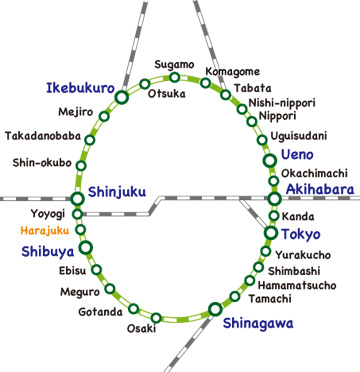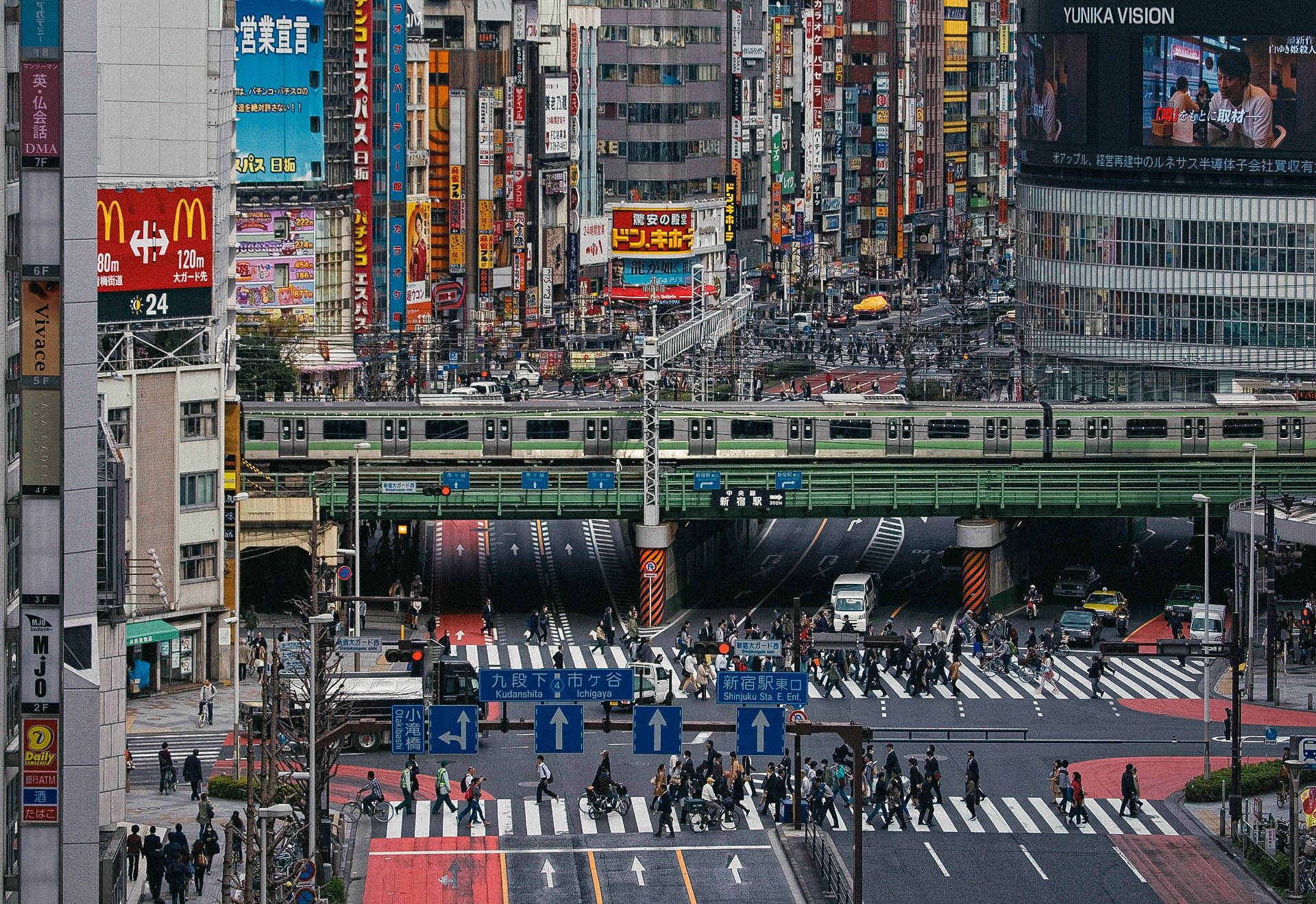Tokyo and the crossroads: Not just Shibuya Scramble
Imagine being immersed in vibrant and dynamic Tokyo, a place where every corner holds a surprise and every street tells a story. Shibuya Crossing is perhaps the epicenter of this overwhelming energy, an iconic symbol immortalized in countless shots. Here, the imposing commercial buildings, the glittering advertising signs and the incessant stream of pedestrians create a unique, almost magical atmosphere. But if your desire is to explore lesser-known, equally fascinating corners, here are five intersections of Tokyo that will make you fall in love with this city even more.

Credits: Savvytokyo
Sukiyabashi Crossing
The first is the Sukiyabashi Crossing in Ginza, a true hidden gem that offers a similar visual and sensory experience to Shibuya. The white and orderly pedestrian lines, together with the vitality of Ginza Sony Park and Sukiyabashi Park, create a futuristic and vibrant atmosphere. But what really makes this intersection special is the majestic Tokyu Plaza Ginza, with its façade inspired by Edo Kiriko glass. Known as the "Gateway to Ginza", this place defines the elegance and luxury of Tokyo's shopping district.

Credits: A. Wee
Nissan Crossing
Continuing into the heart of Ginza, you will find yourself at the intersection of Seiko House Ginza. This spot evokes the glamour of New York's Fifth Avenue, with its glittering shop windows and refined architecture. Here, Japanese luxury is palpable: on the one hand, the sophisticated Seiko watches; on the other, Nissan's cutting-edge cars and the innovative Sony showroom. Every corner exudes elegance and craftsmanship of the highest standard.

Credits japantravel.navitime.com
Roppongi Crossing
Moving to Roppongi, we find an intersection that shines especially at night. The lights of the skyscrapers illuminate the sky, creating an enchanting atmosphere. Roppongi Crossing is crossed by the Metropolitan Expressway, an imposing structure that adds a touch of urban grandeur. The "Roppongi" signs on the freeway are an unmistakable landmark, a symbol of this lively and cosmopolitan neighbourhood. When in the area, don't miss the opportunity to visit one of the many trendy bars in Roppongi.

Credits B.Lucava
Kabukicho Crossing
Another unmissable intersection is Kabukicho in Shinjuku. Here, Godzilla's head poking out of the Toho Cinema provides a surreal and iconic scene. Kabukicho is the beating heart of Tokyo's nightlife, with its neon signs, restaurants and bars crowded with students and salarymen. This red-light district, with its mix of pop culture and lively energy, offers endless photo opportunities and a unique experience.

Credits J. Jenkin
Asakusa Crossing
Finally, we cannot forget Asakusa Crossing, which marks the entrance to Nakamise-dori and leads to the majestic Sensoji Temple. This is one of the most recognizable views of Tokyo, dominated by the Kaminarimon Gate with its imposing lantern. The atmosphere here is steeped in history and tradition, enriched by the rickshaws that await tourists at the entrance. Crossing the street, you will find the Asakusa Culture Tourist Information Center, designed by Kengo Kuma, where you can enjoy breathtaking views of the surrounding area.
These crossings represent the essence of Tokyo, a city that knows how to surprise and fascinate every corner. Get ready to discover the magic that lies in these urban wonders and be inspired by their unique beauty.
Lucky Red Announces the Opening of the Online Store Dedicated to Studio Ghibli
The day that all anime and Japanese culture fans have been waiting for has arrived: we are thrilled to announce the opening of the Lucky Shop, the online store where you can find products inspired by the most beloved films distributed by Lucky Red! And as the cherry on the cake, an entire section of the store will be dedicated to the magical world of Studio Ghibli!
The Magic of Studio Ghibli
Studio Ghibli is one of the most popular and globally celebrated film production companies, founded in 1985 by masters Hayao Miyazaki and Isao Takahata. Since their first feature film, 'Laputa: Castle in the Sky' (1986), they have captured the hearts of young and old alike with their enchanting stories and breathtaking animation.
What makes Studio Ghibli so special? Firstly, the attention to detail and impeccable craftsmanship that characterizes every single frame of their films. Films such as "My Neighbour Totoro", "Spirited Away" and "Princess Mononoke" are not just captivating tales, but true visual masterpieces that wonderfully combine fantasy, nature and humanity.
Their ability to create imaginary worlds inhabited by complex and fascinating characters has made Studio Ghibli a worldwide cultural phenomenon. Who has never dreamed of flying with Totoro, exploring enchanted worlds with Chihiro, or fighting for nature alongside Ashitaka?
The Arrival of the New Lucky Shop Online
And now, the news you've all been waiting for: finally, Studio Ghibli has opened its official online store thanks to Lucky Red! Yes, that's right, you can now bring a piece of the magical Ghibli world directly into your homes.
On Saturday 15 June, Lucky Red announced via its social accounts the opening of the Lucky Shop. From 15 to 22 June, a special promotion will be running: by entering the code LUCKY10 in the appropriate field during purchase, you will receive a 10% discount on all products. The promotion is nominal and each person will only be able to use it once, and will not include shipping costs.

Credits: luckyred.it
An Universe of Magical Products
In the new online store, you will find a wide range of products celebrating the legacy and creativity of Studio Ghibli. One section will be entirely dedicated to official Studio Ghibli products, allowing you to always carry with you the magic of the stories created by Hayao Miyazaki and Isao Takahata imported directly from Japan!
There will be collectable figures of your favourite characters, soft Totoro plush toys, accessories, stationery, and collectables. For true fans, the wonderful Steelbooks have unique illustrations and fine details that turn each piece into a work of art.
The store will also offer special editions of DVDs and Blu-rays, art books and soundtracks that will allow you to immerse yourself even further into the Ghibli universe. And for those who like to dress in style, there will be a selection of exclusive clothing and accessories that will make you feel part of the enchanted world every day.

Credits: luckyred.it
A Unique Shopping Experience
Browsing the new Lucky Shop will be an experience in itself. The site design reflects the beauty and simplicity typical of Studio Ghibli, with sections dedicated to each film and themed collections that will make it easy and fun to find the perfect gift for yourself or another fan of the Ghibli world.
In addition, the store promises to offer international shipping, so that no one is left behind, no matter where you are in the world. Imagine receiving a package that carries some of the magic and wonder of Studio Ghibli, ready to enrich your everyday life!

Credits: luckyred.it
The opening of the Lucky Shop will surely bring a huge “Totoro-like” smile to all fans: your next piece of magic is waiting for you!
Happy shopping!
Il più grande spettacolo di mapping del mondo si tiene a Shinjuku, ora con Godzilla
The Tokyo Metropolitan Government Building, or Tochō, is one of Shinjuku's most recognisable landmarks. Home to the Tokyo Metropolitan Government, completed in 1990 and designed by architect Kenzo Tange, this iconic building now serves as the backdrop for a projection mapping show and has been certified by Guinness World Records as the largest permanent display of its kind in the world!

Photo Credits: mainichi.jp
From sunset to about 9 pm, the building transforms into a huge canvas expressing a variety of art with light and sound. The shows follow a truly extensive calendar for every taste that varies between weekdays, weekends and holidays
On 27 April this year, the show “Godzilla: Attack on Tokyo!” debuted: a huge 100-metre Godzilla destroys Tochō and beyond! A real destructive attack on the metropolis!

Photo credits: japan-forward.com
Shinjuku was the backdrop for the epic battle between Godzilla and King Ghidorah in the 1991 movie, and this year, on the 70th anniversary of the first 1954 movie, Godzilla attacked the city's landmark!
We believe that being amazed watching such a show is a necessity! So everyone keep your eyes on it!
If you want to be kept up-to-date on the screening schedule and not miss anything, please visit tokyoprojectionmappingproject.jp
Travel with us
If you are also curious to see this incredible show, Japan Italy Bridge has just launched its exclusive “Your Japan”, a trip to Japan tailor-made for Italian tourists. This autumn, you will have the chance to go with us to Tokyo. An All Inclusive experience that will allow you to discover the beauties of the capital of Japan. Japan Italy Bridge will take care of everything, from booking flights and hotels to planning your travel plan. Furthermore, our guides will leave with you from Italy and will accompany you along the entire Japanese route.
So what are you waiting for? The time has come to pack your suitcase and travel with us!
Tokyo's Sailor Moon manholes are now installed in Azabu-Juban
The manhole covers dedicated to Sailor Moon arrive in Tokyo, a journey to be discovered, seen and photographed. In Japan, several cities decorate their manhole covers in creative and artistic ways. This practice, known as “manhole art” or “manhole covers”, has become increasingly popular in recent years as a form of artistic expression and tourist promotion. Each region often has its own distinctive designs, which may depict local landscapes, characteristic flora and fauna, cultural symbols or even famous anime and manga characters.

Photos: city.minato.tokyo.jp
Five illustrations dedicated to Sailor Moon have appeared in as many locations in Minato City, a district that has special significance for this famous and beloved series: Usagi (Sailor Moon's real name) lives and attends school in the Azabu-Juban district and several of the story's battle scenes take place there!
The official website of the town of Minato has published a map with the exact location of the colourful manhole covers:

Photos: city.minato.tokyo.jp
1 - Sailor Moon and Tuxedo Mask can be seen near the entrance to the main shopping street of Azabu-Juban.
2 - Sailor Guardians with a blue background can be found in front of the Minato Library, near Shiba Park
3 - The Sailor Guardians in kimono can be found near Toyo Eiwa Jogakuin Primary School



Photos: city.minato.tokyo.jp
4- The Sailor Guardians with a green background are located near Tokyo Tower, inside Shiba Park, in front of the water station.
5- The Sailor Guardians with a yellow background can be seen at the entrance to the Keio-Nakadori shopping street, a place that appears frequently in the anime!


Photos: city.minato.tokyo.jp
How about hunting down all five manhole covers while walking around Tokyo?
Tokyo è classificata come la sesta città più percorribile al mondo
Have you ever wondered in which cities getting around without your own transport (such as a car or scooter) is quick and easy? We live in this situation every day and driven by curiosity, we browsed some rankings and... Tokyo is often considered one of the most efficient and walkable cities in the world!
Its public transport network is extremely developed and well organised, with trains and subways covering the entire area efficiently. In addition, the city is known for its cleanliness, safety and ease of orientation, factors that contribute to its reputation.



It is common for companies and organisations to produce such rankings to assess the liveability of cities based on their accessibility without the use of a car. This time it was the insurance company Compare the Market AU that published the list of the main cities where getting around without a car is advantageous and Tokyo appears in sixth place! Incidentally, it appears to be the only non-European city to make the list:
Monaco (Germania)
1- Munich (Germany)
2- Milan (Italy)
3- Warsaw (Poland)
4- Helsinki (Finland)
5- Paris (France)
6- Tokyo (Japan)
7- Madrid (Spain)
8- Oslo (Norway)
9- Copenhagen (Denmark)
10- Amsterdam (Netherlands)
Did you ever imagine this? We expected it: every time we have been to Tokyo, we have never encountered any problems reaching any destination we wanted to visit!

What do you think? Do you agree with the ranking? Or would you have included other cities?
Bandai Namco: il paradiso di gamer e otaku
“Bandai Namco”, especially if you know the world of video games, anime and manga. However, if there is anyone who doesn't know it yet, we'll introduce it to you: Bandai Namco Entertainment is one of the leading companies in the entertainment sector with a wide range of activities and a strong worldwide presence. Its iconic franchises ("Tekken", "Soulcalibur", "Dark Souls", "Tales of", "Ace Combat", "Dragon Ball" to name a few) make it a dominant force in the gamer and otaku world!


The company also operates numerous amusement arcades and theme parks and, in the heart of Akihabara, known as the Japanese electronics and pop culture district, stands Namco Akihabara, also known as Namco Namjatown: a popular 6-story entertainment complex!
Namco Akihabara
Gamers, collectors of action figures, trading cards and anime lovers are you listening? Good, because this is your paradise!
The first two floors are full of "claw machines" (or "crane games" or prize cranes, where it is possible to grab your prize through a sort of "paw" and a mechanism of the machine): you can try to win everything that you enjoy spending a lot of time (and money!!) chasing the most coveted prize!
The third floor is dedicated to arcade games including eight Taiko no Tatsujin drum machines. You really shouldn't lack rhythm and you must know how to be ready to sweat!



On the fourth floor, you will be impressed by the 800 Namco capsule toy machines (the famous gashapon ガシャポン) where you can win small gadgets of all kinds in a totally random way!
Going up to the fifth floor the world of Bandai collectable cards opens up and, if you feel well prepared, you could even try your hand at real card game battles!
But now let's go back down and go to the basement: do you know Gundam right? Very good, this is the place dedicated to its video games of which Bandai Namco owns the copyrights! There are 44 Mobile Suit Gundam Extreme Vs 2 OverBoost games available and special events are regularly held.
Of course, entry to the huge complex is free, with payment required just to play each game.

Ultimately, Namco Akihabara is a lively and fun place that perfectly represents the spirit of Akihabara and offers a unique experience for visitors to Tokyo, especially those who are interested in Japanese pop culture and entertainment… and….YOU COULD VISIT IT TOGETHER WITH US!
Your Japan - come to Japan with us
Your Japan is a project born from the minds of Japan Italy Bridge in collaboration with Giramondo Viaggi Grezzana and Bandai Namco. Together with our experts, you will have the opportunity to live a unique experience in the city of a thousand colours: Tokyo.
One of the largest megacities in the world where modernity coexists with traditional Japan. An almost perfect fusion that allows us to move from the zen atmospheres of the gardens of the Imperial Palace, up to the lively neighborhoods of Shinjuku and Akihabara. And it is precisely in this last area that the horizons open up to all manga and anime lovers. No matter how old you are, here is the right place to find "old" historical video games, or the newest releases on the market. From classic names such as Pac-man to Dragon Ball, passing through famous titles such as Kenshiro, City Hunter, Saint Seiya up to more recent titles such as Tekken.



Our partners
The GiraMondo Viaggi brand was born in the historic center of Verona in 1979 with a single travel agency. Over the years, the brand grew, becoming a group, with many travel agencies, present on the national and international territory.
There are currently around one hundred agencies, with the GiraMondo brand, each with its own shop and unique location in Italy and abroad.
A leader in the global entertainment industry, BANDAI NAMCO Entertainment Europe publishes and distributes video games and entertainment products in Europe, the Middle East, Africa and Asia-Pacific. The company philosophy is "More Fun For Everyone".
The group's mission is to bring "more fun for all" around the world, with the aim of becoming the leaders of innovation in global entertainment.
From their European headquarters in Lyon they work on titles such as Pac-Man, Soulcalibur, Tekken and Dark Souls… as well as new projects such as Little Nightmares, Twin Mirror and The Dark Pictures.
The tour leaders of "Your Japan"
Our package is designed to give you all the attention necessary for you to experience a unique and unforgettable experience. In fact, our Italian staff will assist you for the entire duration of the trip. Our tour leaders will depart from Malpensa with you and will accompany you for the entire duration of your stay, until your return to Italy.


In these 8 days, our staff will take you to discover the Japanese capital, with exclusive experiences and trips out of town to also admire the Momiji, the period of the year in which the change of foliage takes place.
Among Ginko trees, temples and skyscrapers, you will have the opportunity to live an unforgettable and above all all-inclusive experience. Our package was created to give travelers the opportunity to not have to think about anything other than enjoying the beauty of this fantastic land. You will therefore not have to worry about flights, hotels or guided tours because everything is included in the price. Furthermore, for those who book by June 30th, they will also have an additional €100 discount per room.
So, what are you waiting for? It's time to pack your suitcase and travel with us!
I 7 giardini giapponesi più belli di Tokyo
Oasis of peace
Normally when we think of the word "city" images of streets, houses, buildings, skyscrapers, chaos, traffic come to mind and we hardly imagine large green parks. Sometimes this is a big mistake because many cities instead hide oases of tranquility right in the heart of their liveliness. Tokyo is an example of this: numerous nihon teien (Japanese gardens) make the metropolis a small paradise of serenity!
Garden design is an important Japanese art form that has part of its roots in Zen Buddhism: the spirituality of natural elements such as ponds and stones blends with the hospitality of the scenic component thanks to the water bowls and tea houses.
Each garden has a different purpose, but the underlying concept is always one: finding solitude as an essential element of inner peace and admiring the succession of the four seasons. Let's now try to visit 7 of them, the most beautiful to immerse ourselves in a harmony of colors that only nature can give us.
 Photo Credits: flickr.com
Photo Credits: flickr.com
1- Koishikawa Korakuen
Located near Iidabashi Station, this garden is a living work of art: designed according to the principle of “miniaturization” that seeks to recreate landscapes on a smaller scale, this extraordinary space includes hills, valleys, ponds and streams. “Daisensui”, the central lake, reflects the sky and the surrounding cherry trees; the red “Engetsukyo”, the “full moon bridge”, offers a breathtaking view of the entire garden
 Photo Credits: flickr.com
Photo Credits: flickr.com
2- Rikugien
Located in the Bunkyo neighborhood, it is one of the few remaining gardens from the Edo era. The name “Rikugien” means “garden of the six principles,” referring to the six schools of Japanese poetry that inspire its design. During spring, the cherry blossoms create a breathtaking sight, while in autumn the leaves change color, transforming the garden into a palette of red, yellow and orange hues.

Photo Credits: flickr.com
3- Hamarikyu Gardens
Located near Tokyo Bay. the garden is designed in the "kaiyu-shiki teien" style, a type of Japanese garden that includes a circular path around a central pond "Shioiri", which is connected to Tokyo Bay and is subject to the tides and the small tea pavilion Nakajima-no-Ochaya, located on an island in the pond. On the wooden bridge you can enjoy a spectacular view of the garden and modern urban architecture.
 Photo Credits: flickr.com
Photo Credits: flickr.com
4- Shinjuku Gyoen
This garden is an oasis of tranquility in the busy Shinjuku district. It offers a wide range of landscapes, including traditional Japanese gardens, Western (English and French) landscape gardens and large expanses of lawns.

Photo Credits: flickr.com
5- Gardens of the Imperial Palace
Also known as East Gardens, the gardens surrounding the Imperial Palace are open to the public year-round and offer a vision of well-tended nature in the heart of Tokyo

Photo Credits: flickr.com
6- Kiyosumi Teien
Located in the Kiyosumi neighborhood, this garden is known for its serene beauty and unique features, including an artificial waterfall and a koi pond surrounded by stones collected throughout Japan by the founder of Mitsubishi Iwasaki Yataro. Several “isowatari”, large stepping stones, are positioned in the shallower parts of the pond where it is possible to admire the reflections of the trees on the water.
 Photo Credits: flickr.com
Photo Credits: flickr.com
7- Nezu Museum Garden
The garden was created together with the museum in 1940 by art collector Nezu Kaichirō, Jr. as one of Tokyo's major cultural institutions. the Nezu Museum and its garden offer a reflection of Japanese history and culture.
 Photo Credits: flickr.com
Photo Credits: flickr.com
Exploring these gardens is a wonderful way to discover the beauty and tranquility that are hidden among the skyscrapers and crowded streets of Tokyo: we always suggest you look around because hidden pearls often require attention to be discovered, but you won't you will certainly regret it! Enjoy a peaceful and refreshing escape from the chaos of urban life.
Yamanote Line: 10 segreti e curiosità da scoprire
Yamanote Line: Ieri e oggi, un destino imprescindibile
Si lo so, quando si parla di storia qualcuno potrebbe storcere il naso e pensare che sarà noioso quello che stiamo per dire, ma abbiate fiducia in noi e continuate a leggere…
La Yamanote Line di Tokyo è una delle linee ferroviarie più importanti e trafficate della città.
Fu aperta nel 1885 dalla società ferroviaria privata Nippon Railway Company. Originariamente, la linea faceva il giro intorno al centro di Tokyo, collegando le principali stazioni ferroviarie della città ed era conosciuta anche come “La via della seta”. Nel corso degli anni, la linea subì diverse estensioni e modifiche per soddisfare la crescente domanda di trasporto nella capitale giapponese diventando un pilastro del trasporto pubblico di Tokyo, giocando un ruolo vitale nel collegare le diverse aree della metropoli.

Photo Credits: https://www.gov-online.go.jp/
Oggi, la Yamanote Line è gestita dalla East Japan Railway Company (JR East) e continua a essere una delle linee ferroviarie più affollate del mondo, trasportando milioni di passeggeri ogni giorno attraverso i quartieri più importanti di Tokyo, come Shibuya, Shinjuku, Ikebukuro e Ueno. La Yamanote Line è diventata un'icona della vita quotidiana a Tokyo e uno dei simboli del sistema ferroviario giapponese altamente efficiente e affidabile.
Yamanote Line: Segreti e Curiosità
Grazie alla Yamanote Line è possibile raggiungere 30 quartieri di Tokyo ed è un vero e proprio tesoro di segreti e curiosità! Saliamo a bordo e scopriamo insieme 10 tappe imperdibili!
 Photo Credits: flickr.com
Photo Credits: flickr.com
1 - Shin-Okubo
Questa stazione è nota come la "piccola Corea" di Tokyo, con una vasta gamma di negozi, ristoranti e caffè che offrono cibo e cultura coreana.
2 - Meguro River Cherry Blossoms
Durante la stagione dei fiori di ciliegio, il tratto del fiume Meguro vicino all’omonima stazione si trasforma in un paradiso di petali rosa.
3 - Nishi-Nippori Yanaka Ginza
Questa piccola via commerciale vicino a Nishi-Nippori è un'oasi di negozi tradizionali e ristoranti rustici che offrono una prospettiva autentica della vita quotidiana a Tokyo.
4 - Sugamo
Conosciuto come il "Harajuku per anziani", Sugamo è popolare tra gli anziani per i suoi negozi che vendono prodotti tradizionali giapponesi e per il tempio Koganji, famoso per la sua pietra della fortuna rossa.
5 - Yūrakuchō Gado-shita
Sotto le tracce della Yamanote a Yūrakuchō si trova un labirinto di piccoli bar e ristoranti chiamato "Gado-shita", che offre un'atmosfera unica e vivace.
6 - Akihabara
Nota come la mecca della cultura otaku, Akihabara è piena di negozi di anime, manga, elettronica e caffè a tema.
7 - Komagome
Questo quartiere è famoso per il giardino Rikugien, uno dei più belli di Tokyo, che offre paesaggi incantevoli in ogni stagione.
8 - Shibuya Crossing View from Starbucks
Mentre Shibuya Crossing è un punto caldo per i turisti, pochi sanno che il Starbucks vicino alla stazione offre una vista panoramica perfetta per osservare il caos urbano di Tokyo dall'alto.
9 - Iidabashi e Koishikawa Korakuen
Questa stazione è vicina al bellissimo giardino giapponese di Koishikawa Korakuen, un'oasi di tranquillità nel cuore di Tokyo.
10 - Meiji Shrine Gyoen
Non lontano dalla stazione di Harajuku, il vasto parco intorno al Santuario Meiji è un luogo ideale per una passeggiata rilassante lontano dal trambusto della città.
 Photo Credits: flickr.com
Photo Credits: flickr.com
Che dite, saliamo a bordo della prossima fermata e andiamo insieme alla scoperta di nuovi luoghi?














